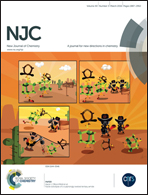Adducts of aqua complexes of Ln3+ with hexahydroxyhexamethylcucurbit[6]uril: potential application in the isolation of heavy lanthanides†
Abstract
The interactions of a series of lanthanide cations (Ln3+) with hexahydroxyhexamethylcucurbit[6]uril (HHQ[6]) have been investigated. The interaction results in the formation of solid crystals of adducts of HHQ[6] with aqua complexes of lanthanide cations of type ([Ln(H2O)8]3+) for Ln = Gd–Lu to yield HHQ[6]–Ln(NO3)3–CdCl2–H2O species in neutral solution. Conversely, no solid crystals were obtained for systems containing La, Ce, Pr, Nd, Sm, or Eu. Unit cell determination by X-ray diffraction shows all of these adducts to be isomorphous. Thermodynamic parameters, Ka, ΔH, and ΔS determined by ITC, show clear differences in the systems involving the six lightest lanthanides compared to those involving the eight heavier lanthanides. Energy-dispersive spectrometry indicated that the lighter or heavier lanthanide cations could be isolated from their heavier or lighter counterparts through interaction with HHQ[6].
![Graphical abstract: Adducts of aqua complexes of Ln3+ with hexahydroxyhexamethylcucurbit[6]uril: potential application in the isolation of heavy lanthanides](/en/Image/Get?imageInfo.ImageType=GA&imageInfo.ImageIdentifier.ManuscriptID=C5NJ00964B&imageInfo.ImageIdentifier.Year=2016)

 Please wait while we load your content...
Please wait while we load your content...